seats CITROEN BERLINGO VAN 2019 Handbook (in English)
[x] Cancel search | Manufacturer: CITROEN, Model Year: 2019, Model line: BERLINGO VAN, Model: CITROEN BERLINGO VAN 2019Pages: 320, PDF Size: 8.91 MB
Page 63 of 320
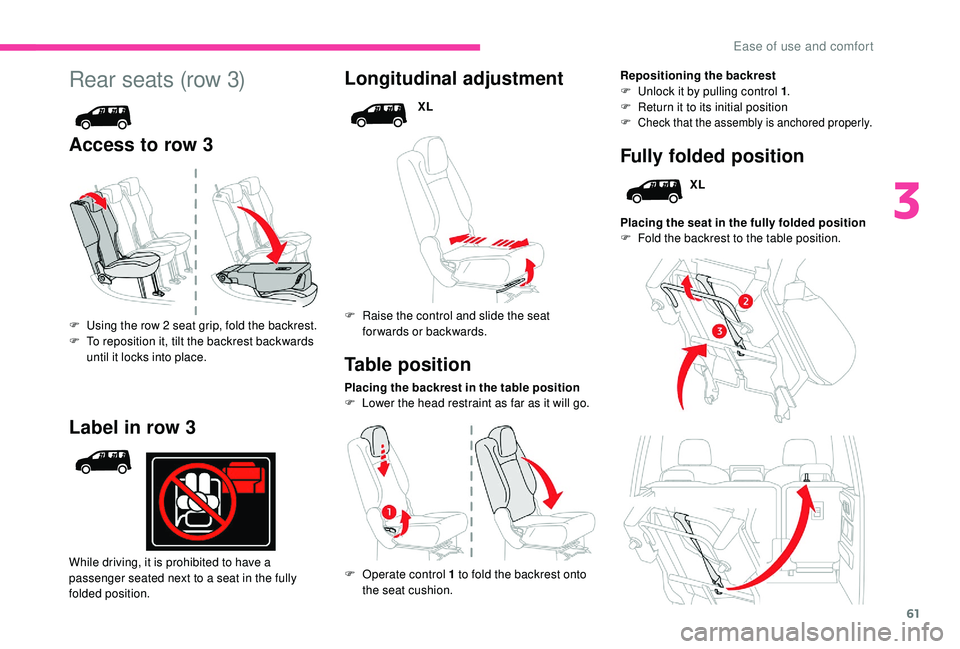
61
Rear seats (row 3)
Access to row 3Longitudinal adjustment
XL
F
Ra
ise the control and slide the seat
forwards or backwards.
Placing the backrest in the table position
F
L
ower the head restraint as far as it will go. Repositioning the backrest
F
U nlock it by pulling control 1
.
F R eturn it to its initial position
F
Check that the assembly is anchored properly.
F Operate control 1 to fold the backrest onto the seat cushion.
Table position
F Using the row 2 seat grip, fold the backrest.
F T o reposition it, tilt the backrest backwards
until it locks into place.
Fully folded position
XL
Placing the seat in the fully folded position
F
F
old the backrest to the table position.
Label in row 3
While driving, it is prohibited to have a
passenger seated next to a seat in the fully
folded position.
3
Ease of use and comfort
Page 66 of 320
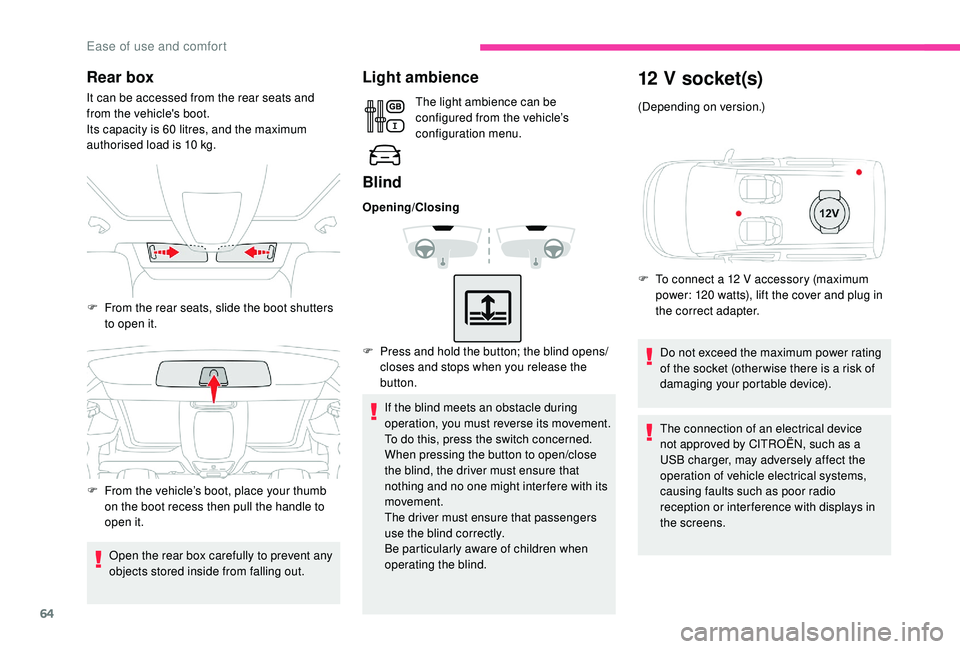
64
Rear box
It can be accessed from the rear seats and
from the vehicle's boot.
Its capacity is 60 litres, and the maximum
authorised load is 10
kg.
Open the rear box carefully to prevent any
objects stored inside from falling out.
Light ambience
The light ambience can be
configured from the vehicle’s
configuration menu.
Blind
Opening/Closing
F
P
ress and hold the button; the blind opens/
closes and stops when you release the
button.
If the blind meets an obstacle during
operation, you must reverse its movement.
To do this, press the switch concerned.
When pressing the button to open/close
the blind, the driver must ensure that
nothing and no one might inter fere with its
movement.
The driver must ensure that passengers
use the blind correctly.
Be particularly aware of children when
operating the blind.
F
F
rom the rear seats, slide the boot shutters
to open it.
F
F
rom the vehicle’s boot, place your thumb
on the boot recess then pull the handle to
open it.
12 V socket(s)
(Depending on version.)
F
T
o connect a 12 V accessory (maximum
power: 120 watts), lift the cover and plug in
the correct adapter.
Do not exceed the maximum power rating
of the socket (other wise there is a risk of
damaging your portable device).
The connection of an electrical device
not approved by CITROËN, such as a
USB charger, may adversely affect the
operation of vehicle electrical systems,
causing faults such as poor radio
reception or inter ference with displays in
the screens.
Ease of use and comfort
Page 70 of 320
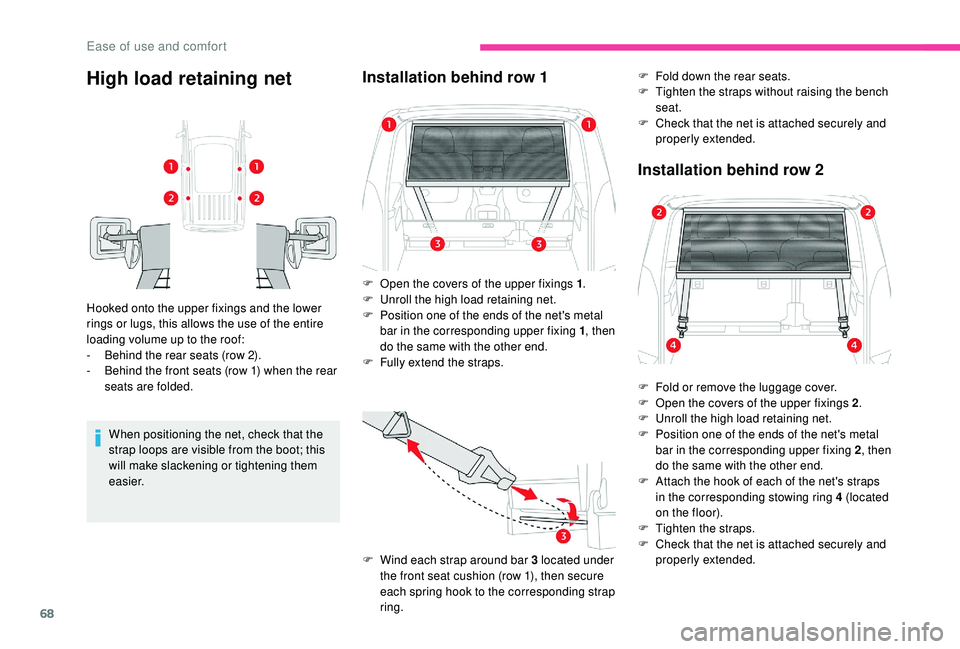
68
High load retaining net
Hooked onto the upper fixings and the lower
rings or lugs, this allows the use of the entire
loading volume up to the roof:
-
B
ehind the rear seats (row 2).
-
B
ehind the front seats (row 1) when the rear
seats are folded.
When positioning the net, check that the
strap loops are visible from the boot; this
will make slackening or tightening them
easier.
Installation behind row 1
F Open the covers of the upper fixings 1 .
F U nroll the high load retaining net.
F
P
osition one of the ends of the net's metal
bar in the corresponding upper fixing 1 , then
do the same with the other end.
F
F
ully extend the straps.
F
W
ind each strap around bar 3 located under
the front seat cushion (row 1), then secure
each spring hook to the corresponding strap
ring.
Installation behind row 2
F Fold or remove the luggage cover.
F O pen the covers of the upper fixings 2 .
F
U
nroll the high load retaining net.
F
P
osition one of the ends of the net's metal
bar in the corresponding upper fixing 2 , then
do the same with the other end.
F
A
ttach the hook of each of the net's straps
in the corresponding stowing ring 4 (located
on the floor).
F
T
ighten the straps.
F
C
heck that the net is attached securely and
properly extended.
F
F
old down the rear seats.
F
T
ighten the straps without raising the bench
seat.
F
C
heck that the net is attached securely and
properly extended.
Ease of use and comfort
Page 71 of 320
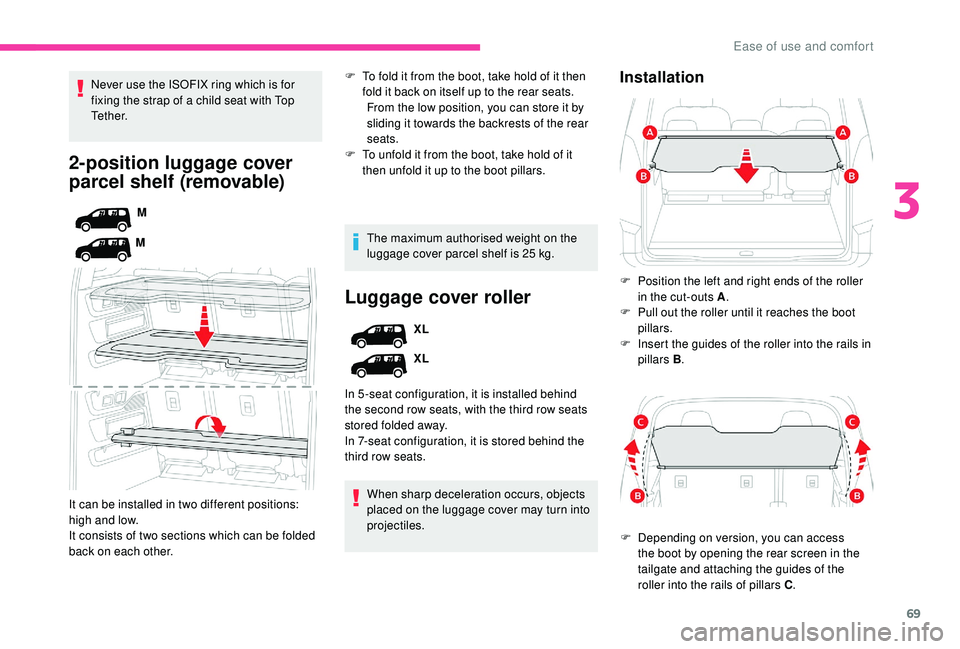
69
2-position luggage cover
parcel shelf (removable)
M
M
It can be installed in two different positions:
high and low.
It consists of two sections which can be folded
back on each other. Never use the ISOFIX ring which is for
fixing the strap of a child seat with Top
Tether.
The maximum authorised weight on the
luggage cover parcel shelf is 25 kg.
F
T
o fold it from the boot, take hold of it then
fold it back on itself up to the rear seats. From the low position, you can store it by
sliding it towards the backrests of the rear
seats.
F
T
o unfold it from the boot, take hold of it
then unfold it up to the boot pillars.
Luggage cover roller
When sharp deceleration occurs, objects
placed on the luggage cover may turn into
projectiles. XL
XL
In 5 -seat configuration, it is installed behind
the second row seats, with the third row seats
stored folded away.
In 7-seat configuration, it is stored behind the
third row seats.
Installation
F Position the left and right ends of the roller in the cut-outs A .
F
P
ull out the roller until it reaches the boot
pillars.
F
I
nsert the guides of the roller into the rails in
pillars B .
F
D
epending on version, you can access
the boot by opening the rear screen in the
tailgate and attaching the guides of the
roller into the rails of pillars C .
3
Ease of use and comfort
Page 102 of 320
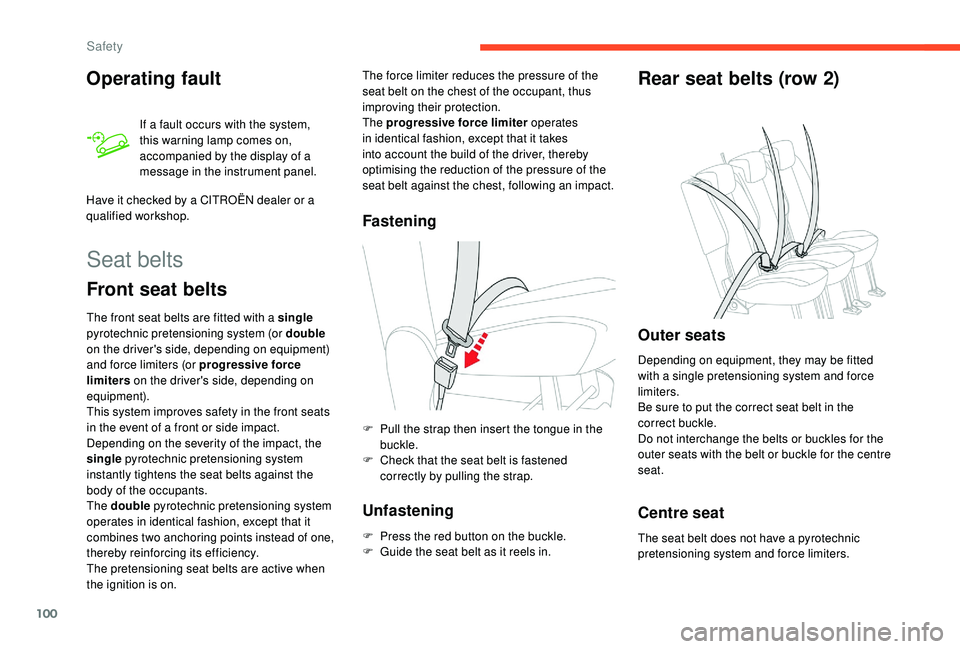
100
Operating fault
If a fault occurs with the system,
this warning lamp comes on,
accompanied by the display of a
message in the instrument panel.
Have it checked by a CITROËN dealer or a
qualified workshop.
Seat belts
Front seat belts
The front seat belts are fitted with a single
pyrotechnic pretensioning system (or double
on the driver's side, depending on equipment)
and force limiters (or progressive force
limiters on the driver's side, depending on
equipment).
This system improves safety in the front seats
in the event of a front or side impact.
Depending on the severity of the impact, the
single pyrotechnic pretensioning system
instantly tightens the seat belts against the
body of the occupants.
The double pyrotechnic pretensioning system
operates in identical fashion, except that it
combines two anchoring points instead of one,
thereby reinforcing its efficiency.
The pretensioning seat belts are active when
the ignition is on.
Fastening
F Pull the strap then insert the tongue in the buckle.
F
C
heck that the seat belt is fastened
correctly by pulling the strap.
Unfastening
F Press the red button on the buckle.
F G uide the seat belt as it reels in.
The force limiter reduces the pressure of the
seat belt on the chest of the occupant, thus
improving their protection.
The progressive force limiter operates
in identical fashion, except that it takes
into account the build of the driver, thereby
optimising the reduction of the pressure of the
seat belt against the chest, following an impact.
Rear seat belts (row 2)
Outer seats
Depending on equipment, they may be fitted
with a single pretensioning system and force
limiters.
Be sure to put the correct seat belt in the
correct buckle.
Do not interchange the belts or buckles for the
outer seats with the belt or buckle for the centre
seat.
Centre seat
The seat belt does not have a pyrotechnic
pretensioning system and force limiters.
Safety
Page 103 of 320
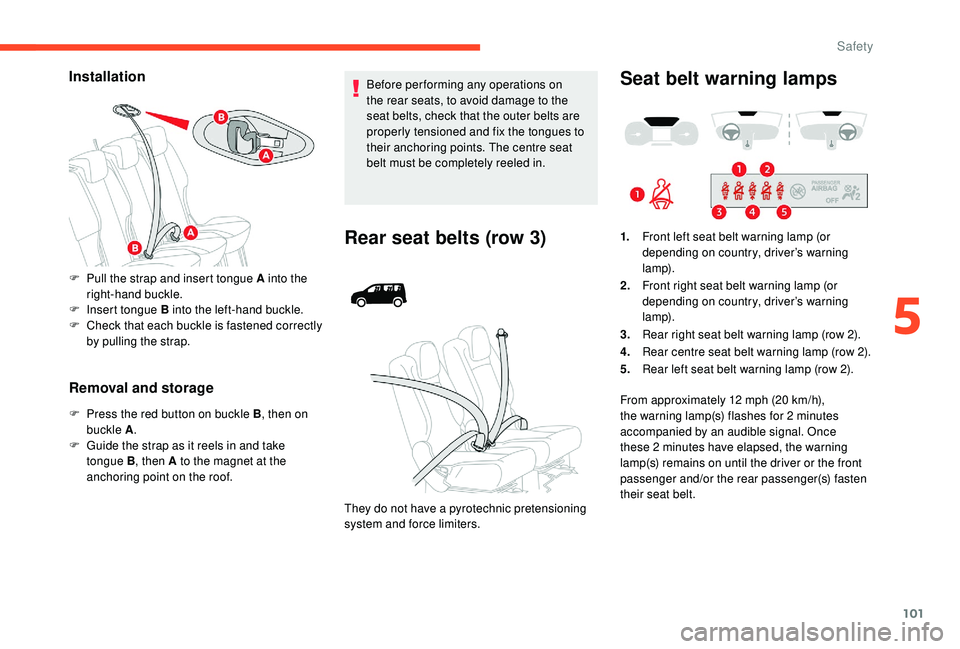
101
Installation
Removal and storage
F Press the red button on buckle B, then on
buckle A .
F
G
uide the strap as it reels in and take
tongue B , then A to the magnet at the
anchoring point on the roof. Before performing any operations on
the rear seats, to avoid damage to the
seat belts, check that the outer belts are
properly tensioned and fix the tongues to
their anchoring points. The centre seat
belt must be completely reeled in.
Rear seat belts (row 3)
F Pull the strap and insert tongue A into the
right-hand buckle.
F
In
sert tongue B into the left-hand buckle.
F
C
heck that each buckle is fastened correctly
by pulling the strap.
They do not have a pyrotechnic pretensioning
system and force limiters.
Seat belt warning lamps
1.Front left seat belt warning lamp (or
depending on country, driver’s warning
lamp).
2. Front right seat belt warning lamp (or
depending on country, driver’s warning
lamp).
3. Rear right seat belt warning lamp (row 2).
4. Rear centre seat belt warning lamp (row 2).
5. Rear left seat belt warning lamp (row 2).
From approximately 12
mph (20 km/h),
the warning lamp(s) flashes for 2
minutes
accompanied by an audible signal. Once
these 2
minutes have elapsed, the warning
lamp(s) remains on until the driver or the front
passenger and/or the rear passenger(s) fasten
their seat belt.
5
Safety
Page 105 of 320
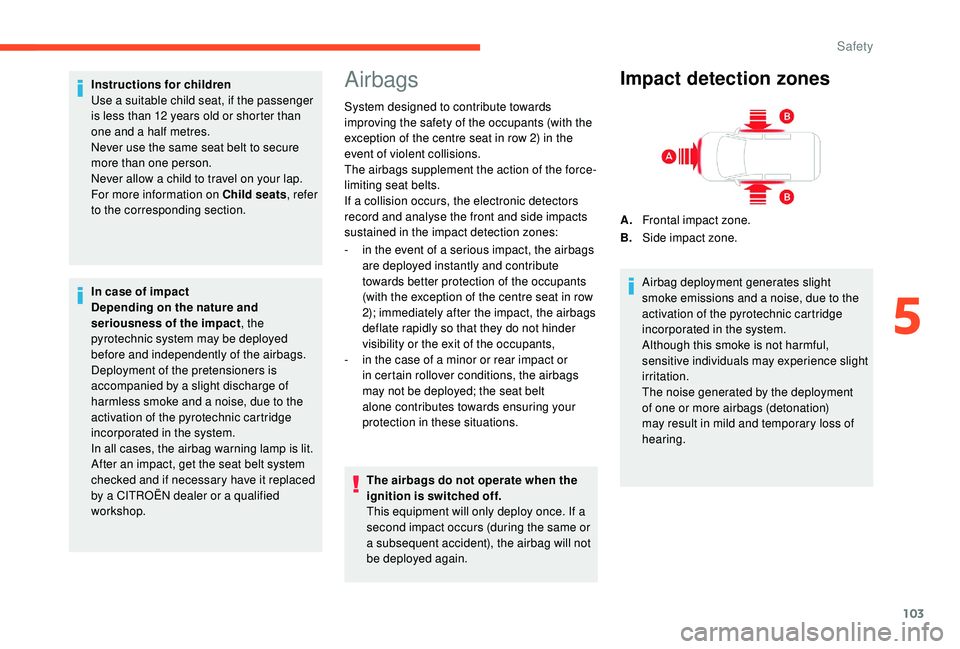
103
Instructions for children
Use a suitable child seat, if the passenger
is less than 12 years old or shorter than
one and a half metres.
Never use the same seat belt to secure
more than one person.
Never allow a child to travel on your lap.
For more information on Child seats , refer
to the corresponding section.
In case of impact
Depending on the nature and
seriousness of the impact , the
pyrotechnic system may be deployed
before and independently of the airbags.
Deployment of the pretensioners is
accompanied by a slight discharge of
harmless smoke and a noise, due to the
activation of the pyrotechnic cartridge
incorporated in the system.
In all cases, the airbag warning lamp is lit.
After an impact, get the seat belt system
checked and if necessary have it replaced
by a CITROËN dealer or a qualified
workshop.Airbags
System designed to contribute towards
improving the safety of the occupants (with the
exception of the centre seat in row 2) in the
event of violent collisions.
The airbags supplement the action of the force-
limiting seat belts.
If a collision occurs, the electronic detectors
record and analyse the front and side impacts
sustained in the impact detection zones:
-
i
n the event of a serious impact, the airbags
are deployed instantly and contribute
towards better protection of the occupants
(with the exception of the centre seat in row
2); immediately after the impact, the airbags
deflate rapidly so that they do not hinder
visibility or the exit of the occupants,
-
i
n the case of a minor or rear impact or
in certain rollover conditions, the airbags
may not be deployed; the seat belt
alone contributes towards ensuring your
protection in these situations.
The airbags do not operate when the
ignition is switched off.
This equipment will only deploy once. If a
second impact occurs (during the same or
a subsequent accident), the airbag will not
be deployed again.
Impact detection zones
A. Frontal impact zone.
B. Side impact zone.
Airbag deployment generates slight
smoke emissions and a noise, due to the
activation of the pyrotechnic cartridge
incorporated in the system.
Although this smoke is not harmful,
sensitive individuals may experience slight
irritation.
The noise generated by the deployment
of one or more airbags (detonation)
may result in mild and temporary loss of
hearing.
5
Safety
Page 107 of 320
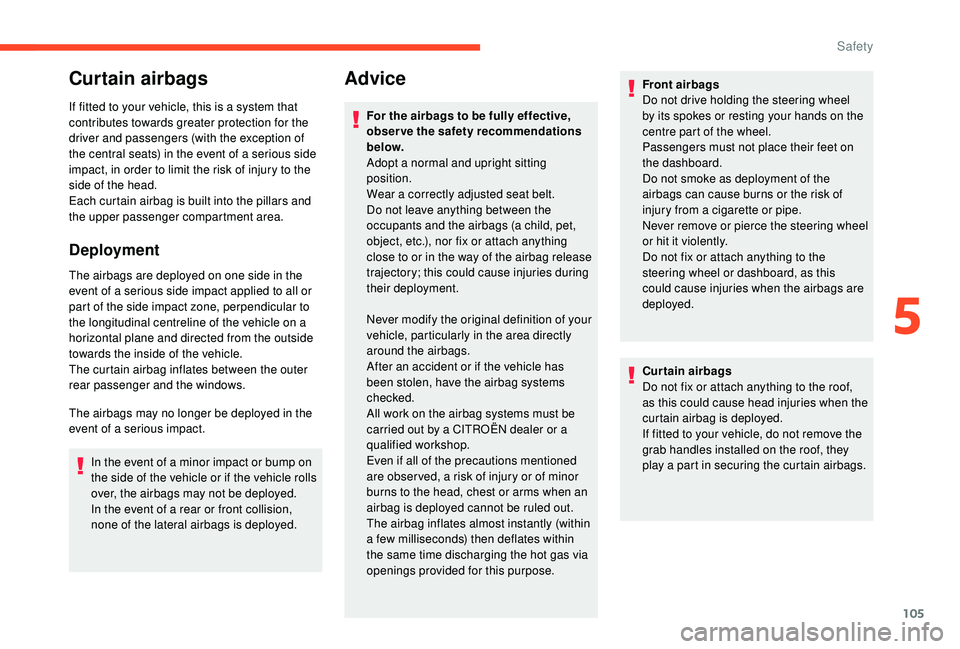
105
Curtain airbags
If fitted to your vehicle, this is a system that
contributes towards greater protection for the
driver and passengers (with the exception of
the central seats) in the event of a serious side
impact, in order to limit the risk of injury to the
side of the head.
Each curtain airbag is built into the pillars and
the upper passenger compartment area.
Deployment
The airbags are deployed on one side in the
event of a serious side impact applied to all or
part of the side impact zone, perpendicular to
the longitudinal centreline of the vehicle on a
horizontal plane and directed from the outside
towards the inside of the vehicle.
The curtain airbag inflates between the outer
rear passenger and the windows.
The airbags may no longer be deployed in the
event of a serious impact.In the event of a minor impact or bump on
the side of the vehicle or if the vehicle rolls
over, the airbags may not be deployed.
In the event of a rear or front collision,
none of the lateral airbags is deployed.
Advice
For the airbags to be fully effective,
observe the safety recommendations
below.
Adopt a normal and upright sitting
position.
Wear a correctly adjusted seat belt.
Do not leave anything between the
occupants and the airbags (a child, pet,
object, etc.), nor fix or attach anything
close to or in the way of the airbag release
trajectory; this could cause injuries during
their deployment.
Never modify the original definition of your
vehicle, particularly in the area directly
around the airbags.
After an accident or if the vehicle has
been stolen, have the airbag systems
checked.
All work on the airbag systems must be
carried out by a CITROËN dealer or a
qualified workshop.
Even if all of the precautions mentioned
are obser ved, a risk of injury or of minor
burns to the head, chest or arms when an
airbag is deployed cannot be ruled out.
The airbag inflates almost instantly (within
a few milliseconds) then deflates within
the same time discharging the hot gas via
openings provided for this purpose. Front airbags
Do not drive holding the steering wheel
by its spokes or resting your hands on the
centre part of the wheel.
Passengers must not place their feet on
the dashboard.
Do not smoke as deployment of the
airbags can cause burns or the risk of
injury from a cigarette or pipe.
Never remove or pierce the steering wheel
or hit it violently.
Do not fix or attach anything to the
steering wheel or dashboard, as this
could cause injuries when the airbags are
deployed.
Curtain airbags
Do not fix or attach anything to the roof,
as this could cause head injuries when the
curtain airbag is deployed.
If fitted to your vehicle, do not remove the
grab handles installed on the roof, they
play a part in securing the curtain airbags.
5
Safety
Page 108 of 320

106
Lateral airbags
Use only approved covers on the seats,
compatible with the deployment of the
lateral airbags. For information on the
product range of seat covers suitable for
your vehicle, contact a CITROËN dealer.
Do not fix or attach anything to the seat
backrests (clothes, etc.), as this could
cause injuries to the thorax or arm when
the lateral airbag is deployed.
Do not sit with the upper part of the body
any nearer to the door than necessary.
The vehicle's front door panels include
side impact sensors.
A damaged door or any unauthorised or
incorrectly executed work (modification or
repair) on the front doors or their interior
trim could compromise the operation of
these sensors – risk of malfunction of the
lateral airbags!
Such work must only be done by a
CITROËN dealer or a qualified workshop.General points relating to
child seats
The regulations on carrying children are
specific to each country. Refer to the
legislation in force in your country.
For maximum safety, please obser ve the
following recommendations:
-
I
n accordance with European regulations,
all children under the age of 12 or less
than one and a half metres tall must
travel in approved child seats suited to
their weight , on seats fitted with a seat belt
or ISOFIX mountings.
-
S
tatistically, the safest seats in your
vehicle for carr ying children are the rear
seats.
-
A c
hild weighing less than 9 kg must
travel in the "rear ward facing" position
both in the front and in the rear.
It is recommended that children travel on
the rear seats of your vehicle:
-
"rearward facing " up to the age of 3,
-
"forward facing " over the age of 3. Ensure that the seat belt is positioned and
tightened correctly.
For child seats with a support leg, ensure
that the support leg is in firm and steady
contact with the floor.
At the front: if necessary, adjust the
passenger seat.
At the rear: if necessary, adjust the
relevant front seat.
Remove and stow the head restraint
before installing a child seat with backrest
on a passenger seat. Refit the head
restraint once the child seat has been
removed.
Child seat at the front
When a child seat is installed on the front
passenger seat
, adjust this seat to the
highest position , in the fully back position ,
with the backrest straightened .
Safety
Page 113 of 320
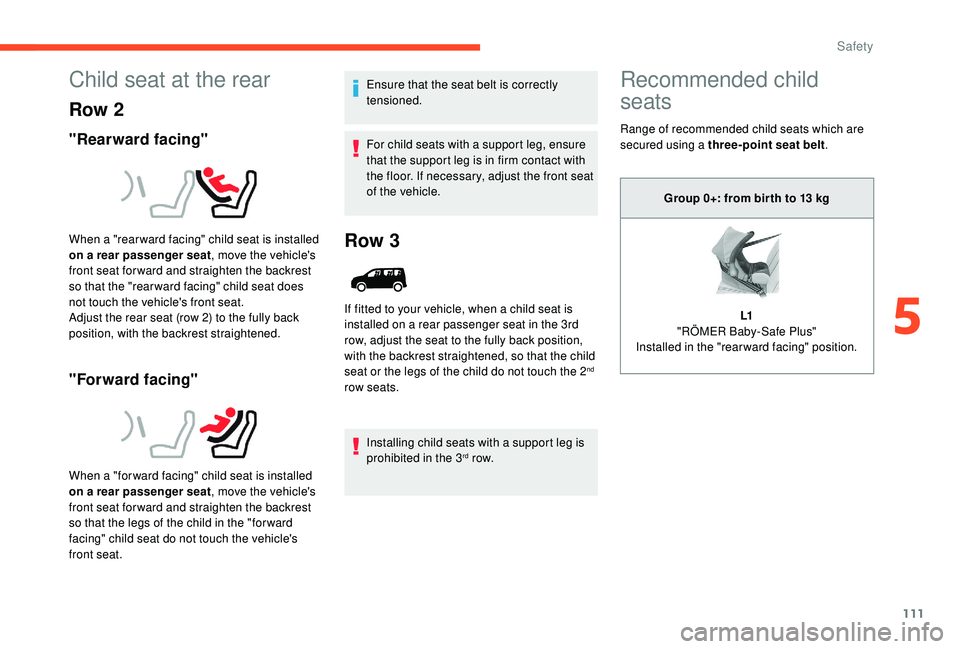
111
Child seat at the rear
Row 2
"Rearward facing"
"Forward facing"
Ensure that the seat belt is correctly
tensioned.
For child seats with a support leg, ensure
that the support leg is in firm contact with
the floor. If necessary, adjust the front seat
of the vehicle.
Row 3
If fitted to your vehicle, when a child seat is
installed on a rear passenger seat in the 3rd
row, adjust the seat to the fully back position,
with the backrest straightened, so that the child
seat or the legs of the child do not touch the 2
nd
row seats.
Installing child seats with a support leg is
prohibited in the 3
rd row.
When a "rear ward facing" child seat is installed
on a rear passenger seat
, move the vehicle's
front seat for ward and straighten the backrest
so that the "rear ward facing" child seat does
not touch the vehicle's front seat.
Adjust the rear seat (row 2) to the fully back
position, with the backrest straightened.
When a "for ward facing" child seat is installed
on a rear passenger seat , move the vehicle's
front seat for ward and straighten the backrest
so that the legs of the child in the "for ward
facing" child seat do not touch the vehicle's
front seat.
Recommended child
seats
Range of recommended child seats which are
secured using a three-point seat belt .
Group 0+: from bir th to 13
kg
L1
"RÖMER Baby-Safe Plus"
Installed in the "rearward facing" position.
5
Safety